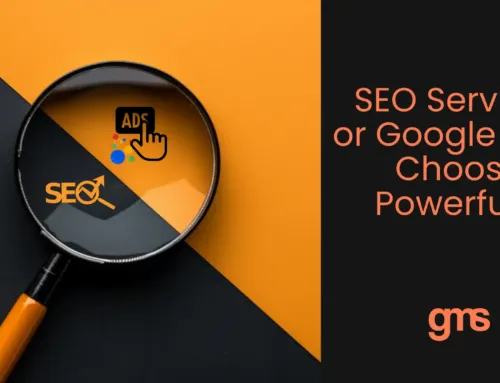SEO Checklist for Black Friday
Every year, Black Friday presents a golden opportunity for e-commerce businesses to boost sales and engage customers. While many companies prioritise paid advertising channels like Facebook Ads or Google Ads, they often overlook the immense potential of organic search optimisation—SEO.
Unlike paid ads, which demand continuous investment, SEO offers a sustainable way to attract traffic and drive conversions. Starting your SEO preparations in September can put your business ahead of the competition, maximising visibility during this peak shopping season.
Like what you are reading? Follow GMS Media on LinkedIn.
For Australian retailers, Black Friday is more than just a shopping event; it’s a pivotal period for boosting sales. In 2022, Australians spent over $5 billion alone during the Black Friday weekend.
With the competition growing fiercer each year, early SEO efforts can ensure your business is a top choice for consumers planning their holiday shopping.
Let’s explore why preparing your SEO strategy now is crucial and how GMS Media can help you get started.
Why Choose SEO for Black Friday With Ads?
Many businesses heavily rely on Facebook Ads or Google Ads to drive sales during Black Friday. However, SEO offers a different, often more sustainable path to success. Ads can quickly become expensive, especially when big businesses increase their spending just before Black Friday and continue throughout the Christmas season. Competing in this space can be tough, particularly for smaller businesses with limited budgets.
SEO, on the other hand, allows you to gain visibility without the escalating costs associated with paid ads.
So use both SEO and paid media ads.
By focusing on SEO, you can build a strong foundation that continues to drive traffic even as ad prices soar. When consumers search for deals online, having your website appear in organic search results can attract potential customers early. Therefore, SEO can help make your e-commerce site a priority for shoppers, ensuring you capture consumer interest and spending before they allocate their budgets elsewhere.
Need help with your SEO? Reach out today and we can get your growth started.
Get Ahead of Big Ad Spenders with SEO
The holiday season sees big businesses ramp up their advertising spend. They often start spending big on Google Ads and Facebook a few days before Black Friday and continue this high spend throughout the Christmas period. This surge in ad spending can make it difficult for smaller businesses to compete effectively.
By focusing on SEO, you can establish a strong online presence without breaking the bank on paid ads. SEO helps level the playing field by allowing smaller businesses to attract organic traffic through well-optimised content.
Starting your SEO efforts in September ensures that your e-commerce site is visible when consumers are in the planning stages of their holiday shopping. By ranking higher in organic search results, you can attract customers who are looking for deals early, reducing the risk of being overshadowed by big brands during the peak shopping period. Ultimately, SEO gives you a competitive edge, allowing you to secure sales before your competitors even get started.
When is Black Friday in 2024?
Black Friday in 2024 falls on Friday, 29th November. This gives you ample time to prepare your SEO strategy if you start now. By optimising your website for SEO in September, you can ensure that your site is fully optimised by the time consumers start searching for deals. This preparation is key to capturing early interest and driving traffic to your site.
Understanding the timing of Black Friday is crucial for your SEO efforts. The earlier you start, the more time you have to implement changes and see results. By the time November rolls around, your site will be well-positioned to attract traffic, making it a top destination for Black Friday shoppers.
Are you a beauty brand? Discover How to Market a Beauty Brand via SEO for Black Friday.
Keyword Research and Content Planning
Keyword research is the foundation of any successful SEO strategy. For Black Friday, it’s essential to identify core keywords that consumers are likely to use when searching for deals on products you offer. Start by using tools like Google Keyword Planner or SEMrush to find keywords related to Black Friday and your specific products or services. Focus on terms that have a high search volume and low competition to maximise your visibility.
Once you have identified your core keywords, create a content calendar for blog posts, product descriptions, and landing pages centred around these keywords. Include terms like “Black Friday deals,” “holiday sales,” and product-specific keywords. By planning your content in advance, you can ensure that it aligns with your SEO strategy and meets the needs of your audience.
Need help with your SEO? Reach out today and we can get your growth started.
On-Page SEO Optimisation
On-page SEO optimisation is critical for ensuring your website is visible in search engine results. Start by auditing your existing content to make sure it aligns with your target keywords and Black Friday intent. Update meta titles, descriptions, and headers to include Black Friday-related terms, and make sure your content is relevant and informative. This helps search engines understand what your site is about and increases your chances of ranking higher in search results.
How to Optimise Product Pages: Step-by-Step Guide
Optimising your product pages for SEO is crucial to ensure they rank well in search engine results and attract organic traffic. Here’s a step-by-step guide to optimising your product pages effectively, using recommended tools like SEMrush, Moz, and Google Search Console.
Step 1: Perform Keyword Research
Begin by identifying the most relevant keywords for each product. These keywords should align with what potential customers are likely to use when searching for your products.
- Use SEMrush or Moz: Enter the product name or a related term into SEMrush or Moz’s keyword research tool. Look for keywords with a high search volume but low to medium competition. These keywords will help you target potential customers without competing with major retailers.
- Analyse Competitors: Check what keywords your competitors are ranking for. Tools like SEMrush allow you to analyse competitors’ websites and see which keywords are driving traffic to their product pages. This can provide valuable insights and help you discover new keyword opportunities.
- Long-Tail Keywords: Don’t overlook long-tail keywords (e.g., “best ergonomic office chair for back pain”). These phrases are more specific, usually less competitive, and often have higher conversion rates because they target customers who are closer to making a purchase decision.
Step 2: Optimise Product Titles and Meta Descriptions
Your product titles and meta descriptions are crucial for both search engines and users. They should be compelling and contain your target keywords.
- Product Titles: Make sure each product title is unique and includes the main keyword. Keep it concise but descriptive. For example, instead of “Office Chair,” use “Ergonomic Office Chair with Lumbar Support – Black Leather.”
- Meta Descriptions: Write a compelling meta description for each product page. It should include the main keyword and be enticing enough to encourage users to click through. For instance, “Discover our ergonomic office chair designed for comfort and style. Perfect for reducing back pain and enhancing productivity.”
- Use Google Search Console: Check how your product pages are currently performing in terms of click-through rates (CTR). If you notice low CTRs, consider rewriting your meta descriptions to make them more engaging and aligned with search intent.
Step 3: Enhance Product Descriptions
Product descriptions play a vital role in both SEO and user experience. They should be detailed, unique, and include relevant keywords.
- Include Keywords Naturally: Use your primary and secondary keywords naturally throughout the product description. Avoid keyword stuffing, as this can harm your SEO rankings and deter customers.
- Focus on Benefits and Features: Highlight the benefits and unique features of the product. Use bullet points for easy readability. This not only improves user experience but also helps search engines understand the product better.
- Answer Common Questions: Incorporate common questions or concerns customers might have about the product. This can improve your SEO by capturing voice search queries and appearing in featured snippets.
Need help with your SEO? Reach out for a FREE 1:1 consultation today.
Step 4: Use High-Quality Images and Optimise Them
Images are essential for showcasing your products, but they must be optimised for SEO as well.
- Use Descriptive File Names: Rename your image files with descriptive, keyword-rich names before uploading them. Instead of “IMG1234.jpg,” use “ergonomic-office-chair-black-leather.jpg.”
- Add Alt Text: Include alt text for each image, describing what is in the image and incorporating relevant keywords. This helps search engines understand the image content and improves accessibility for users with visual impairments.
- Compress Images: Use tools like SEMrush’s image optimisation feature to reduce the file size of your images without compromising quality. Faster-loading images improve page speed, which is a crucial factor for SEO.
Step 5: Implement Schema Markup
Schema markup, also known as structured data, helps search engines better understand the content on your product pages and can enhance your search listings with rich results.
- Add Product Schema: Use Google’s Structured Data Markup Helper to add product schema to your pages. This can include details such as price, availability, and customer ratings, which can improve your search appearance and attract more clicks.
- Monitor with Google Search Console: After implementing schema markup, use Google Search Console to check for any errors or issues. This tool will notify you if there are problems with your structured data so you can fix them promptly.
Step 6: Optimise Internal Links
Internal linking helps search engines understand the structure of your website and can distribute page authority more effectively.
- Link to Related Products: On each product page, link to related products to encourage further browsing and keep visitors on your site longer. This can also help search engines discover and index more of your pages.
- Use Descriptive Anchor Text: When linking to other pages, use descriptive anchor text that includes keywords related to the destination page. For example, “Check out our collection of ergonomic office chairs” instead of just “click here.”
Step 7: Monitor and Analyse Performance
After optimising your product pages, it’s crucial to monitor their performance to understand what’s working and what might need further improvement.
- Track Rankings with SEMrush or Moz: Use these tools to monitor your keyword rankings over time. If certain keywords are not performing well, consider revisiting your optimisation strategy for those pages.
- Analyse User Behaviour with Google Analytics: Check metrics such as bounce rate, average session duration, and conversion rate for your product pages. High bounce rates may indicate that the content is not meeting user expectations, while low conversion rates could suggest issues with the product page layout or checkout process.
- Use Google Search Console for Insights: Regularly check Google Search Console for updates on your site’s health, including crawl errors, index coverage issues, and potential penalties. This tool also provides valuable insights into which queries are driving traffic to your product pages.
Need help with your SEO? Reach out for a FREE 1:1 consultation today.
Link Building and External SEO Efforts
Link building is an important part of any SEO strategy. An effective internal linking strategy can help guide visitors from blog posts or older content to Black Friday-specific pages, increasing the chances of conversion. Make sure to link to relevant pages within your site to keep visitors engaged and encourage them to explore more of your content.
In addition to internal linking, building backlinks from reputable sites can improve your SEO. Consider collaborating with influencers or bloggers who can promote your Black Friday deals. Guest posts and partnerships can also help you reach a wider audience and drive traffic to your site. Remember, building these relationships and links takes time, so it’s important to start early.
Local SEO and Google My Business (GMB) Optimisation For Black Friday
For businesses with physical locations, optimising for local search is essential. Ensure your Google My Business profile is up-to-date and reflects your Black Friday hours and promotions. Local SEO helps you attract customers who are searching for deals in your area, making it easier for them to find and visit your store.
Encouraging customers to leave positive reviews can also improve your local search rankings. Reviews build trust and credibility, which can influence potential customers’ decisions to visit your store or shop online. Start collecting reviews well before Black Friday to build a strong online reputation and attract more customers.
Monitoring and Analytics Setup
Tracking key metrics is crucial for measuring the success of your SEO efforts. Use tools like Google Analytics and Google Search Console to monitor metrics such as organic traffic, bounce rates, and conversion rates. Regular monitoring allows you to see what’s working and make adjustments as needed to improve your site’s performance.
Setting up conversion tracking is also important for understanding how your site is performing during Black Friday. By tracking specific goals, such as email sign-ups or purchases, you can gain valuable insights into what’s driving conversions and optimise your strategy accordingly. Monitoring your analytics regularly will help you stay on top of your SEO efforts and make informed decisions.
SEO Content Strategy for Black Friday Success
Creating content that drives conversions is key to a successful Black Friday. Product roundups and comparison articles can help customers make informed decisions and find the best deals on your site. Focus on creating content that is informative, engaging, and aligned with your SEO strategy.
Buying guides are another effective content type that can drive conversions. Target keywords like “best Black Friday deals for [product]” to attract customers who are searching for specific items. Customer testimonials and case studies can also build trust and credibility, making it more likely that visitors will choose your site over competitors.
Engage with Email and Social Media
Email campaigns are a powerful tool for building anticipation and driving traffic to your site. Plan your email campaigns in advance to provide exclusive previews of Black Friday deals and engage with your audience. Segment your email list to target specific groups of customers and maximise your reach.
Social media is another effective way to engage with customers and promote your Black Friday deals. Use social media teasers to create excitement and drive traffic to your site. Align your social media content with your SEO efforts by using similar keywords and phrases, ensuring a consistent message across all channels.
Technical Preparations for Black Friday Traffic Surges
Ensuring your website can handle the increased traffic during Black Friday is crucial for a smooth shopping experience. Perform load testing to identify potential issues and optimise your site’s performance. Review your hosting plans and server performance to avoid downtime during peak traffic periods.
Security is also an important consideration for Black Friday. Make sure your site has an SSL certificate and other security measures in place to protect customer data. Optimise your payment gateways for quick and secure transactions, ensuring a seamless checkout process for your customers.
Need help with your SEO? Reach out for a FREE 1:1 consultation today.
Starting your SEO preparations in September is essential for capturing early consumer interest and driving traffic to your e-commerce site. By focusing on keyword research, on-page optimisation, link building, and local SEO, you can ensure your site is visible when customers are searching for Black Friday deals. Engaging with email and social media, and preparing for traffic surges will help you provide a smooth and enjoyable shopping experience for your customers. Make sure to monitor your analytics regularly and adjust your strategy as needed to maximise your success.
Take action now to start optimising your SEO strategy for Black Friday, and ensure your business stands out in the competitive Australian retail market. By preparing early, you can capture consumer spending before your competitors and set your business up for a successful holiday season.
About the Author
GMS Media Group, founded in 2016 by Blake Micola and co-founded by Simon Train, is a leading digital marketing agency dedicated to transforming brands’ online presence through tailored strategies and high-quality content. With a focus on data-driven insights and innovative tools, GMS Media Group helps businesses achieve significant growth and engagement across digital platforms.
Whether you’re looking to optimise your SEO strategy or elevate your Google Ad campaigns, GMS Media Group is here to take your brand to the next level.
Contact GMS Media Group today and watch your online presence flourish.
Like what you are reading? Follow GMS Media on LinkedIn.




